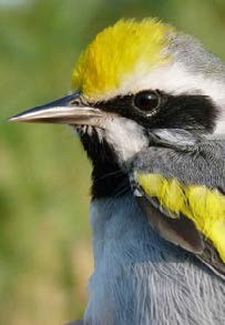The golden-winged warbler is a threatened songbird species in Manitoba with unique habitat requirements – and we’ve hatched a plan to protect them.
Recently we built a transmission line project in southeastern Manitoba, extending from our Dorsey station to the Manitoba-Minnesota border south of Piney. It intersected with a critical habitat area for golden-winged warblers – and thanks to our right-of-way habitat management plan, studies have shown the construction and operation of this 40-kilometre (70-span) transmission line has had no apparent negative effect on the species.
“This is an environmental success story,” said Jonathan Wiens, an environmental specialist at Manitoba Hydro. “The project took collaboration between design engineers and environmental specialists, and we are pleased our teamwork paid off.”
Managing the natural vegetation around the line is key to striking this balance.

The ‘right-of-way’ is the land within the 100-metre corridor of the transmission line. We usually clear these areas of vegetation to allow large equipment access. In this case, we did clear the right-of-way, but we retained many shrubs and small trees in key areas, as they are critical breeding habitat for the golden-winged warbler.
“This does take added effort and planning with engineers, contractors, and inspectors,” said Jonathan. “Through integrated vegetation management we hope to continue to promote the right mix of habitat on the right-of-way, while maintaining the safety and reliability of the line.”
To measure the project’s effect on the species, we conducted a multi-year study between 2017 and 2021: we conducted bird surveys in the pre-construction, construction, and post-construction phases with consulting support provided by Wildlife Resource Consulting Services MB Inc.
Bird experts used playback speakers to play the call of the golden-winged warbler – if any were present, they would call back, helping us determine the number of birds in the area around the transmission line. We then repeated this and compared results at reference sites one to two kilometres away from the line. This way, we could make sure that any potential changes in golden-winged warbler populations on the right-of-way weren’t due to other factors.

The studies showed there was no difference in golden-winged warbler occupancy between the pre-construction and post-construction phases. This indicates that the construction and early operation of the transmission line has had no apparent effect on the golden-winged warbler.
Since the power line is international, we needed to conduct a detailed environmental impact statement to meet federal and provincial regulations. This required Manitoba Hydro to provide extensive details on how we would mitigate the project’s effect on this threatened songbird.
All evidence suggests that as the vegetation regenerates and goes through regular maintenance, the golden-winged warbler will continue to thrive in the area.
Read more about our commitment to the environment in our Environment, Social, and Governance Report.




